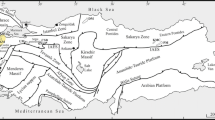Abstract
The Wild Bight Group (WBG) and South Lake Igneous Complex (SLIC) together comprise one of the Ordovician accreted oceanic terranes of the central mobile belt of the Newfoundland Appalachians. Combined detailed mapping, geochemistry, Sm-Nd isotopic studies and U-Pb geochronology have shown that sheeted dykes and hornblende diorite and tonalite plutons of the SLIC are genetically related to a discrete package of volcanic rocks in the WBG. These igneous rocks are geochemically, isotopically and temporally distinct from volcanic rocks in the rest of the WBG. Plutonic rocks of the SLIC range in age from 486 ± 3 Ma to 489 ± 3 Ma, and a cross-cutting gabbro dyke gives a minimum age of 486 ± 4 Ma for the related volcanic sequence. Volcanic rocks in the rest of the WBG sequence are predominantly younger than 472 ± 3 Ma. The older volcanic sequence of the WBG and the SLIC occur as fault-bounded packages interleaved within the younger WBG sequence. A conformable stratigraphic relationship between the older and younger sequences of the WBG has not been demonstrated. The mafic rocks of the older package include boninites and low-Ti, high-Mg tholeiitic island arc basalts which are interpreted to be genetically related, and normal island arc tholeiites (IAT). The high-Mg mafic rocks are interpreted to have formed in an extensional setting during subduction zone initiation, and the normal IAT are thought to represent stabilisation of the volcanic front. The associated high-Si, low-K rhyolite and tonalite are interpreted to be the products of secondary melting at the base of thickened early arc crust. Sm-Nd isotopic compositions indicate that the characteristic trace element signature of the boninites developed at or near their time of generation and was not a long lived characteristic of the source region. The boninites and low-Ti tholeiites are interpreted to have originated from a similar source, which was metasomatized by different subduction-related components. Apparent decoupling of Sm-Nd geochemical and isotopic compositions suggests that these very depleted rocks may be recording the effect of subduction zone processes not yet fully understood.
Similar content being viewed by others
Author information
Authors and Affiliations
Additional information
Received: 31 October 1997 / Accepted: 6 May 1998
Rights and permissions
About this article
Cite this article
MacLachlan, K., Dunning, G. U-Pb ages and tectonomagmatic relationships of early Ordovician low-Ti tholeiites, boninites and related plutonic rocks in central Newfoundland, Canada. Contrib Mineral Petrol 133, 235–258 (1998). https://doi.org/10.1007/s004100050450
Issue Date:
DOI: https://doi.org/10.1007/s004100050450




